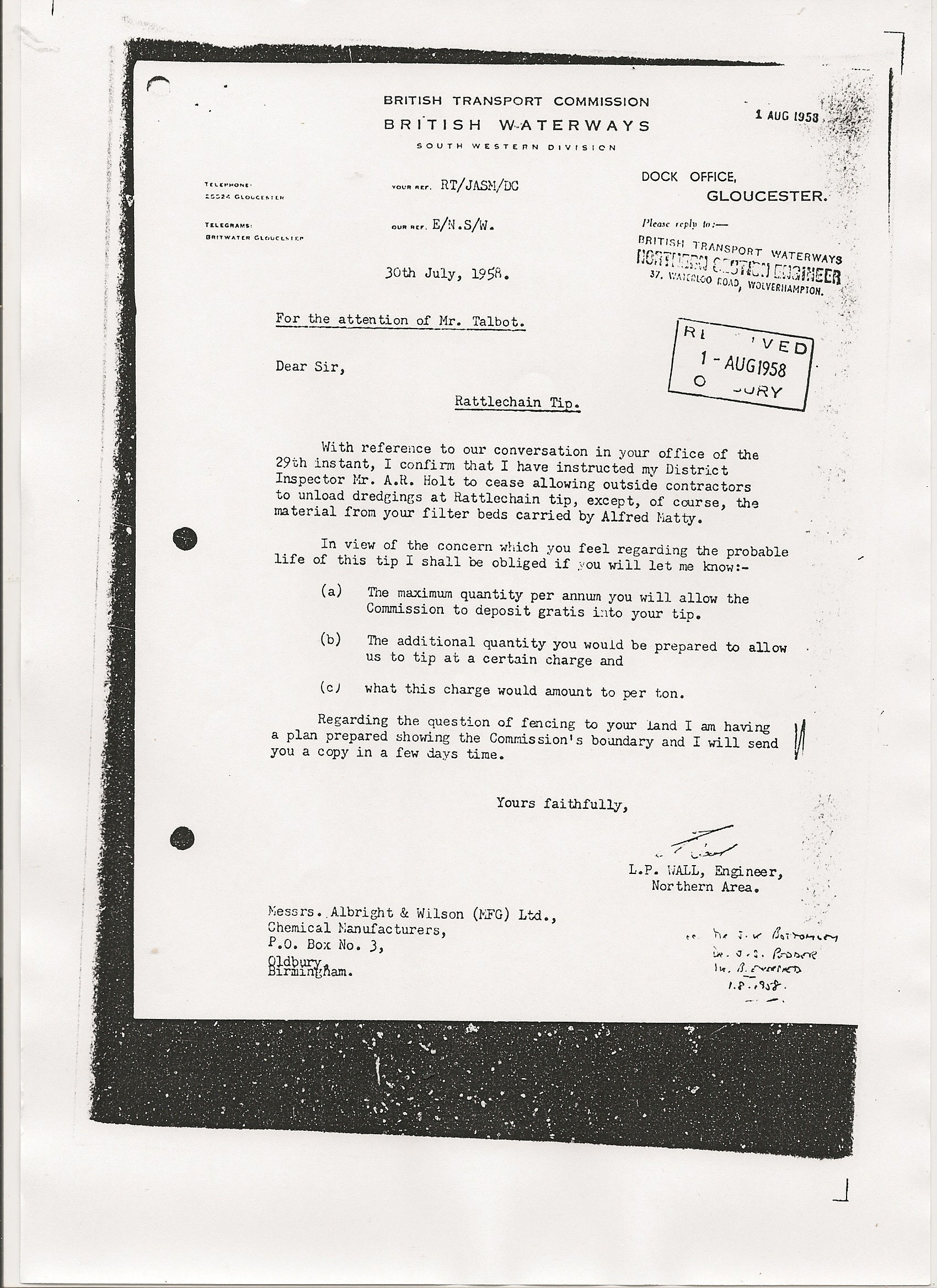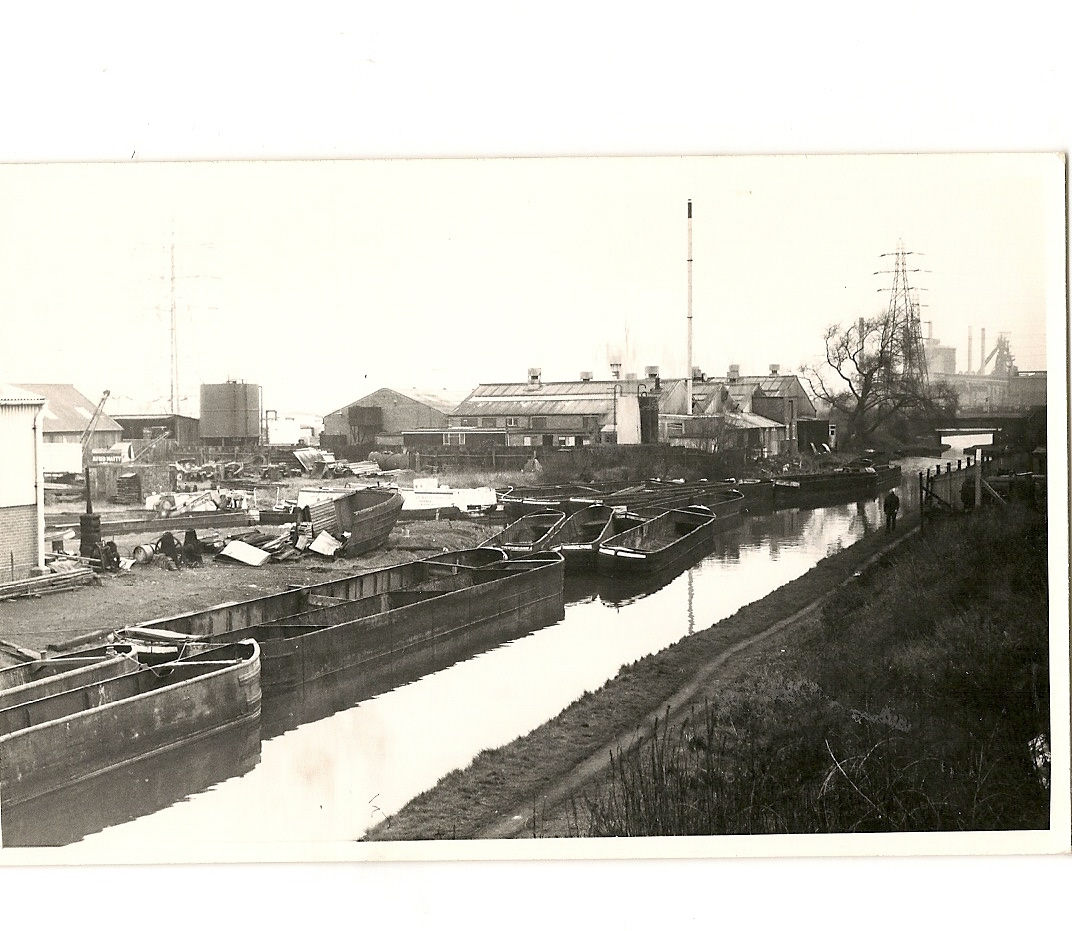CANAL POLLUTION
Accounts of pollution around the Houghton chemical arm from where Albright and Wilson historically loaded their waste materials for disposal at Rattlechain are confirmed in a British Waterways canal inspection report dated 16th November 1961,where the inspector comments
“Area badly polluted by soda ash and phosphor, Albright and Wilson.”
The toxic trail- from The Houghton Chemical arm Trinity Street to Rattlechain lagoon via The Birmingham canal Old and New mainlines is shown below- click to view larger version.
Not only does this route potentially pollute several miles of canal, but also considered should be that it extended back to the boatyard at Coseley.
Using The Freedom of Information Act, we were able to obtain historic deed maps of the route, showing the extent of other industries operating around the BCN network over time from The former British Waterways. This should be born in mind when considering information revealed in letters below.
To follow this route in detail:
Entrance from Houghton chemical arm going left onto Birmingham Old mainline canal. sheet no 50
Continuation towards Oldbury under Seven Stars Road the entrance to the filled in Churchbridge branch and associated basins upto highbridge at Furnace Street/ now in the Rounds Green Road area.Sheet no 49
Continuation of old mainline canal, showing several pieces of land were subsequently bought by Accles and Pollocks. Also showing a part of the filled in Oldbury loop and The Oldbury brickworks.Sheet 47
Continuation of canal through Brades Bridge area towards Gower Branch. Sheet 46
Gower basin and entrance to the Gower Branch. Also shows Brades Hall colliery, the boiler works and the Hange Furnaces and associated basins further on. Sheet 45
Gower branch/Monks Tip to the junction of mainline canal. Sheet ?
RATTLECHAIN Brickworks/lagoon area. Sheet 25
Netherton Branch/Stour Valley brickworks area . Sheet 24
A further map of the general Rattlechain area was also supplied here.
An authoritative internet published account of carrying canal waste to Rattlechain before legislation is provided by narrow boat enthusiast Malcolm Edge in his memoir
The Alfred Matty boat “Maureen” and a second towed boat reportedly made two to three trips per day between Oldbury and Rattlechain to dispose of the factory waste. The last “official” cargo was reportedly made in 1970 where after deliveries switched to road tanker but there is strong anecdotal and verified evidence that this continued after this date into the 1970’s, perhaps later as specific one off dredging contracts. Paul Bartlett who worked for Matty’s on this phosphorus run has confirmed this in a very informative recollection of the trade.
A file note from Sandwell Council’s conservation officer concerning infilling of a part of the Houghton chemical Arm is outlined below. His account is also supported by The Inland Waterways Association publication “Birmingham Canal Navigations- a cruising and walking guide.” This was published in 1984, and so this makes its recency to the cease of the trade a credible source. NB- WASTE TIPPING AT RATTLECHAIN VIA BOAT WAS CONTINUING AFTER THE DEPOSIT OF POISONOUS WASTE ACT AND UPTO THE CONTROL OF POLLUTION ACT 1974.
Having spoken at some length to Mr Edge about the work of the Alfred Matty boats and the Rattlechain site, he has provided a map of the location of the pipe and pumphouse located at the site as described in his memoir. He has made the following annotation.

“The marl hole shown between Rattlechain Mere and the canal where Autobase site now is, was also there in my childhood but was not the place that Phosphorous was tipped, that was definitely Rattlechain mere, we just called it the ‘Chemical pool’. The other marl hole, ‘the Vono tip’, was the one owned by the bed company Vono and was used for tipping the trade waste from their bed making factory which was brought by tractor/trailer over a concrete bridge which used to span the Netherton branch just down Dudley Port Junction.”
Anecdotal accounts of Albright and Wilson’s pollution of the canals is confirmed in the subsequent letters obtained by swanwatch. They also show a direct involvement of collaboration of waste tipping by British Waterways Board, Later British waterways.
The first from 1958 confirms that they paid Albright and Wilson a fee for disposing of their own waste dredgings. That the land between theirs and Albright and Wilson’s was unfenced and that there appeared to be a tipping free for all at the site given the companies concern at “the life of the tip”. This is a stark indicator when considering the waste that the site really contains- NOT JUST THAT WHICH CAME FROM ALBRIGHT AND WILSON ACTIVITIES, BUT MANY POLLUTING INDUSTRIES ACROSS THE ENTIRE CANAL NETWORK OF THE AREA!
The following letter from 1960 confirms that British Waterways Board were absent minded in their reported quantities of waste tipping into the Albright and Wilson site. The Gower Branch tip refered to (Monks Tip) is now located next to the Hindu Temple.
The following letter from Albright and Wilson from 1963 confirms their will to remove an electrically operated chute, refered to in Mr Edge’s memoir and annotated map. They intend to raise the water levels in the single lagoon which indicates that the white phosphorus in the lagoon was perhaps giving them concern. Perhaps they were afraid of a child getting injured or more likely they wanted to increase the life of the tip by adding more water to fill up the hole in the ground.
The following letter from British Waterways from 1970 confirms the pollution that Albright and Wilson tipping is causing in the vicinity of the Rattlechain Tip. The build up of “light grey silt just below the water level” that both knew about is extremely worrying. There is little doubt here that white phosphorus contamination from Albright and Wilson activities was not restricted to a contained process between factory and waste tip, but along the whole length of the journey between the two.

British waterways confirming pollution caused by Albright and Wilson’s waste materials in Birmingham canal.
Another primary source of information concerning the canal landscape as it stood in the early 1970’s is vividly recalled in “Staffordshire” by Vivian Bird, Batsford 1974. The author in chapter two “Lost territory- The Black Country undertook a canal boat journey with legendary canal boat man “Caggy” Stevens.
It appears that the canal network at this point in history was a spectrum of colours, all based on the local polluting factory source, or cargo that was carried via boats but ended up spilt.
“Turning into the Wyrley and Essington Canal at Catshill Stop we had a lunchtime drink at “the Anchor”, and in another mile reached our destination. The canal, milky at Oldbury, smoking with phosphorus at Tipton, bottle-green at West Bromwich, and weedy at Rushall, was now deep and crystal clear.”
THE FOLLOWING KEY POINTS CAN BE DEDUCED FROM THESE SOURCES.
- BW were allowing their “outside contractors” to unload dredging since at least 1958- the date of the first letter
- This waste, before legislation such as the 1972 Deposit of Poisonous Wastes Act, could have contained anything from the other chemical industries in the area who also polluted the canal network with toxic wastes.
- This means that the types of waste comprising the lagoon cannot be limited to the waste types manufactured by Albright and Wilson alone, something never considered by any published study relating to this site, including the commissioned Health Protection Agency Human Health risk assessment.
- This tipping bonanza was a free arrangement, but BW queried what charge Albright and Wilson would impose on them for continuing these operations.
- There was no fencing on the site, or apparent boundaries of the site.
- By 1960 it appears that Albright and Wilson were charging them. The BW “new tip” referred to on The Gower Branch canal, was known as “Monk’s Tip” – see map below
- There was an agreement between the two to allow up to 2,500 tonnes of dredgings per year.
- This appears to have ceased by around 1961 from the letter dated 22nd January 1963.
- But after this they appear once again to be using the site in 1970, around the time that Alfred Matty were slowing down delivering waste via canal boat as a regular contract.
- Accounts of dire pollution along the surrounding area with white phosphorus are clearly evident.
- These accounts of evidence do not support the Freedom of information request answered by British Waterways concerning how they disposed of dredged waste along the Birmingham Canal Navigations.
Above, The Alfred Matty boat yard at Coseley in a picture dated 15/3/1975. By now the days of carrying waste for Albright and Wilson to Rattlechain had passed and the canal carrying trade had almost died out, which from an environmental point of view was good riddance. The legacy it left however is another question!
We would like to know if you recall Alfred Matty’s boats delivering waste to Rattlechain, or the pollution that the practice caused. Were you a boater or canal user during this period? What did you see or smell on the cut?
COMMENTS
“You dont seem to have a publication date on this, so your sourse may be the same as mine. book of ROBERT DAVIES, MIDLANDS CANALS.
mr.Enoch describes dumping wastes of phosphorous using the boat MAUREEN.”
“It was foul and dangerous. When I worked on Vesta in Les Allens yard I kept the children in the car. The smell pervades all over Oldbury. Our iron hull was phosphated a rust prevention process.”
“Hello,
Could you tell me the source of the maps that you have used to show the toxic trail please”
“A couple of questions on sources.
Barry, the toxic trail map is from an old Warley Street plan-blue lines and skull and crossbones my own- toxic waste courtesy of Mssrs Albright/Wilson and Matty.
Ib Rasmussen? Are you Danish? I intend to put another page up soon concerning the book in question which you correctly identify, and the observations made within it!
Enoch’s Epitaph- A place “in which nothing could live” | What Lies Beneath Rattlechain Lagoon?
If you have any memories or observations about this subject guys, I would appreciate your input. Cheers.”
“As the controversy about the rattlechain tip drags on – express &; star the other night- I decided to look on the net and what went on with the chemical traffic. It looks like it will be a problem for a long time. The reason I have responded to your request is that I remember the matty boats and I have a couple of slides some where that I took. The previous write up said that it finished about 1970 but may have continued later. It did, my slides date from early 1972. Regards roy martin.”
“Roy has kindly provided us with pictures and a write- up concerning the Matty chemical run to Rattlechain. This can be read at http://whatliesbeneathrattlechainlagoon.org.uk/?page_id=3645″












5 Responses to Canal pollution